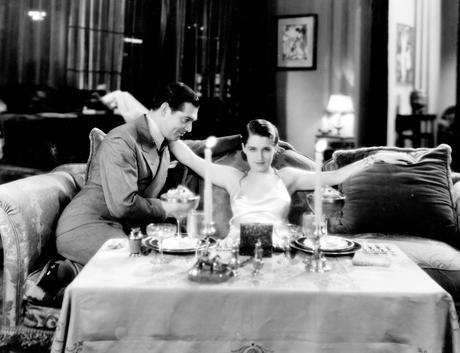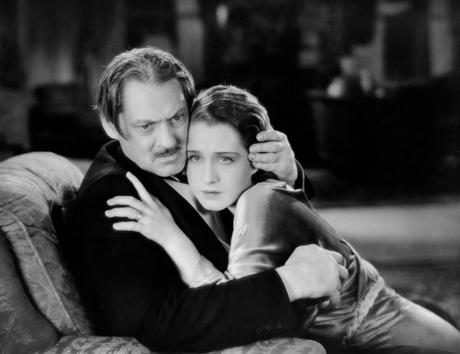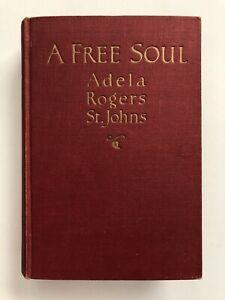
Without a doubt, 1931’s A Free Soul is a pre-Code essential. The story about a woman romantically torn between her conventionally respectable boyfriend and a known underworld figure is perfect pre-Code material all by itself, but when you add in the smarmy charm of a young Clark Gable and Norma Shearer wearing some very slinky evening gowns and robes, it’s pure gold. Lionel Barrymore also took home a Best Actor Academy Award for his performance and the movie proved to be a big hit for MGM. But before A Free Soul was a hit movie, it was a book by Adela Rogers St. Johns first published in 1927. So how do they compare?
Book & Movie Differences
To call the film version of A Free Soul a loose adaptation of the book is putting it mildly. They both feature a criminal defense lawyer and his daughter, whom he is very close with. The father, Stephen (played by Lionel Barrymore), struggles with alcoholism while his daughter, Jan (played by Norma Shearer), falls in love with a notorious gambler. They agree to a wager where they each give up what they love and take a trip to put things behind them, but the father struggles to give up drinking and later disappears for a while. Eventually, the father comes back to take care of a big trial because of a murder involving someone the daughter had been seeing. That’s about where the similarities end.

Perhaps the most significant difference between the book and the movie is the fact that the roles of Ace Wilfong (played by Clark Gable) and Dwight Sutro (played by Leslie Howard) are essentially switched. In the movie, Jan and Dwight are happy together until Ace comes along and Jan can’t resist his more dangerous allure. But in the book, Dwight had been out of the country for a few years and when he comes back to San Francisco and finds out Jan had gotten married, that doesn’t stop him from trying to see if he can start something up with her again. And since Jan is a bit lonely because of the hours Ace keeps, it’s easy for her to go along with it. When Ace finds out about it, he shoots Dwight in his home.
In the movie, we only see Jan as an adult, but the book paints a much larger picture of her life and her relationship with her father. The book tells stories about Jan’s childhood and teenage years. We find out that Jan has been dealing with Stephen’s alcoholism much longer than the movie suggests. For example, the book details an incident when 13-year-old Jan comes home in a cab in the early morning hours because Stephen had brought her to a gambling house, then got drunk and forgot about her, forcing her to find her own way home. We also learn why Jan’s mother wasn’t in the picture and why Stephen was determined to raise her in the unconventional manner that he had.

The book also gives us a more of a look at Ace Wilfong’s life, going back to the first time he crossed paths with Stephen and Jan Ashe when Ace was just a kid selling violets on the street and looked up to Stephen as a personal hero. We also learn more about Ace’s family, particularly his sister who has a rather rocky relationship with Jan because of jealousy over her marriage to Ace.
The character of Ace Wilfong is a great example of how, even in the pre-Code era, characters like gangsters, gamblers, and criminals needed to be written in certain ways in movies to avoid glorifying them. In the book, Ace doesn’t seem like that bad of a guy — aside from the part where he shoots Dwight, of course. Yes, Ace is a gambler, but he’s described as something of a respectable gambler. He seems to genuinely adore Jan and mentions wanting to eventually get out of gambling and into something more legitimate. Even when facing the death penalty, Ace remains loyal to Stephen when all logic and reason would tell him to work with a lawyer who isn’t just coming off of a long drinking binge. The movie version of Ace is rougher and more aggressive.
Is the Book Worth Reading?

Out of all the books I’ve read as part of the summer reading challenge, A Free Soul is the one where I most strongly prefer the movie over the book. The film version of A Free Soul is a strong, well-paced drama with some great performances. The book has a much slower pace and it takes a long time before you get to the parts that are most related to what happens in the movie. It’s a very slow burn, reaching its most exciting point with the events leading up to Ace shooting Dwight. I usually don’t mind a book that takes time to build to something and the parts that were good were enjoyable, but you have to get through a lot of other material to get to that point.
On the whole, it wasn’t my favorite book by any means, but I’m glad I was at least able to check it out for the sake of my own curiosity. Perhaps if you’re A Free Soul superfan and love the characters so much that you want to spend more time with them and get to know them more in depth, then it may be worth tracking down a copy of the book. But while the same thing can be said of Fast Times at Ridgemont High, I don’t know that anyone has the same level of affection for characters like Jan Ashe and Ace Wilfong that they have for Jeff Spicoli.
This review is part of the 2021 Classic Film Summer Reading Challenge hosted by Out of the Past. For more reviews on books related to classic film, be sure to follow the #ClassicFilmReading hashtag on social media.
